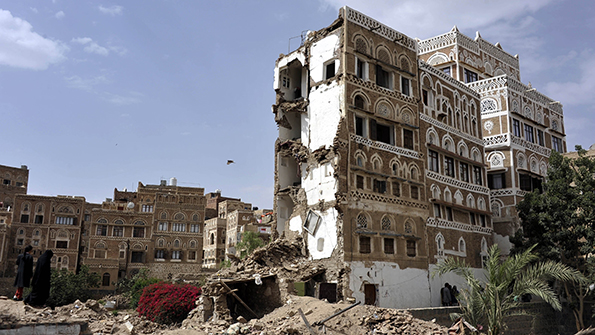
ANYBODY who follows the international media will be aware that some terrible harm has been done to the world's spiritual and cultural heritage in the course of fighting in Syria and Iraq; and that some of this destruction is a result of deliberate efforts by Islamic State fighters to eliminate all structures which are out of step with their own narrow understanding of Sunni Islam.
But there is another country in the region where a sectarian civil war, with an international dimension, is wreaking major damage to religious and architectural treasures, and that conflict is getting much less international attention. The country is Yemen, where a Saudi-led coalition of Sunni Arab states has been waging war by air and land against the Houthis, a Shia rebel group who control the capital, Sana'a, and are denounced by their foes as a proxy for Iran.
The roster of antiquities damaged in the war in Yemen runs long. Missiles fired from the coalition's planes have obliterated a museum (where the fruits of an American-Yemeni archaeological dig were stored), historic caked-mud high-rise dwellings, 12th century citadels and minarets and other places whose importance to humanity's heritage has been recognised by the UN. The Great Dam of Marib, a feat of engineering that was undertaken 2,800 years ago, has been struck four times, most recently on August 18th. Antiquities experts fear for the oldest surviving fragment of the Koran, in a six-month war which has killed over 4,000 and injured 20,000.
But apparently out of deference to their Saudi and Gulf friends, Western powers have yet to make much comment on the destruction in Yemen, whether humanitarian or cultural. They have expressed justified horror over cultural losses in Syria, such as Islamic State's demolition of the Bel temple in Palmyra. They willingly subscribe to the general principle of protecting religious and cultural objects from war.
Yet Western officialdom has been tongue-tied about Yemen; Britain's Foreign Office, for instance, did not respond when asked about the cultural damage there. In the ancient city of Sana'a, a UNESCO World Heritage site, there is a bitter feeling that the West is applying lenient standards to a coalition whose members are strategic allies and defence customers. Mohannad al-Sayani, director of Yemen's General Organisation of Antiquities and Museums, laments that his country is suffering cultural vandalism whose ideological purpose resembles the campaign against Syrian and Iraqi antiquities. In all cases, people are bent on wiping out what they consider to be "idolatry"—in other words, any object that in their view signals deviation from the strict path laid down by the Prophet Muhammad and his immediate successors. In addition to the strikes from the air, he says, ruthless local branches of Islamic State and al-Qaeda are making ground attacks on Yemen's cultural sites.
Lamya Khalidi, a France-based archaeologist who worked for many years in Yemen, says the Saudi-led coalition must surely know what it is bombing; its munitions are high-precision, and it has received a list of sensitive heritage sites, drawn up in the vain hope that would be spared. It is at least somewhat heartening that UNESCO, the UN's cultural arm, has spoken out on the subject; in June it held a conference in Paris and condemned the multiple acts of cultural destruction that have taken place in Yemen, including the bombing of two places it has designated as World Heritage sites. UNESCO is also concerned by the wrecking of the Dhamar museum, which housed over 12,000 artefacts, and by air attacks on the archaeological excavation sites at Baraqish and Sirwah, both impressive pre-Islamic walled cities. Behind the scenes, the United States too is financing an anticipated Red List of antiquities at risk, to be produced by the Paris-based International Council of Museums. But America does this discreetly for fear of embarrassing its Saudi and Gulf allies.
While the relationship between intentions and results in aerial warfare can be foggy, other damage is being done by al-Qaeda forces, fighting along Yemen’s southern coast, who make no secret of their purpose. They have threatened to destroy the "idols" in the museum of Mukallah port, and destroyed two Sufi shrines, including a 700-year-old mosque in Lahj, a short way inland.
In Aden, the main southern port, Sunni fighters who were under bombardment by the Houthis responded by destroying a Shia mosque. Other traces of non-Sunni culture were wrecked too, including the gravestones of Chinese workers who built the coastal road in the 1960s. Perhaps the latter were deemed to be relics of atheism, dating from the 1970s when Yemen was a socialist republic, says Thanos Petouris, a Yemen expert who released footage of their destruction.
As with any belligerent in any war, the Houthis have an agenda too; they naturally want to draw attention to cultural vandalism in the hope that the West will snap out of its indifference and rein in the Saudi-led coalition. The Houthi side has also done some damage to historic sites and monuments, including a statue of Queen Victoria which has been defaced by gunshots. After Aden was pounded by the Houthis and their allies, loyal to former president Ali Abdullah Saleh, the country's only Christian cemetery and an Indian mosque were left in ruins. Opportunistic developers might also have helped to bomb the sites, eyeing a chance to turn old city-centre buildings into prime real estate.
But for people who love Yemen's extraordinary history, ranging from pre-historic walled towns to some of the most finely decorated mosques in the world, a great irreversible tragedy is occurring. The country was once known as Arabia Felix, Happy Arabia, because of its dominance of the incense trading route. Now that felicity is a thing of the past, and not enough people have noticed.